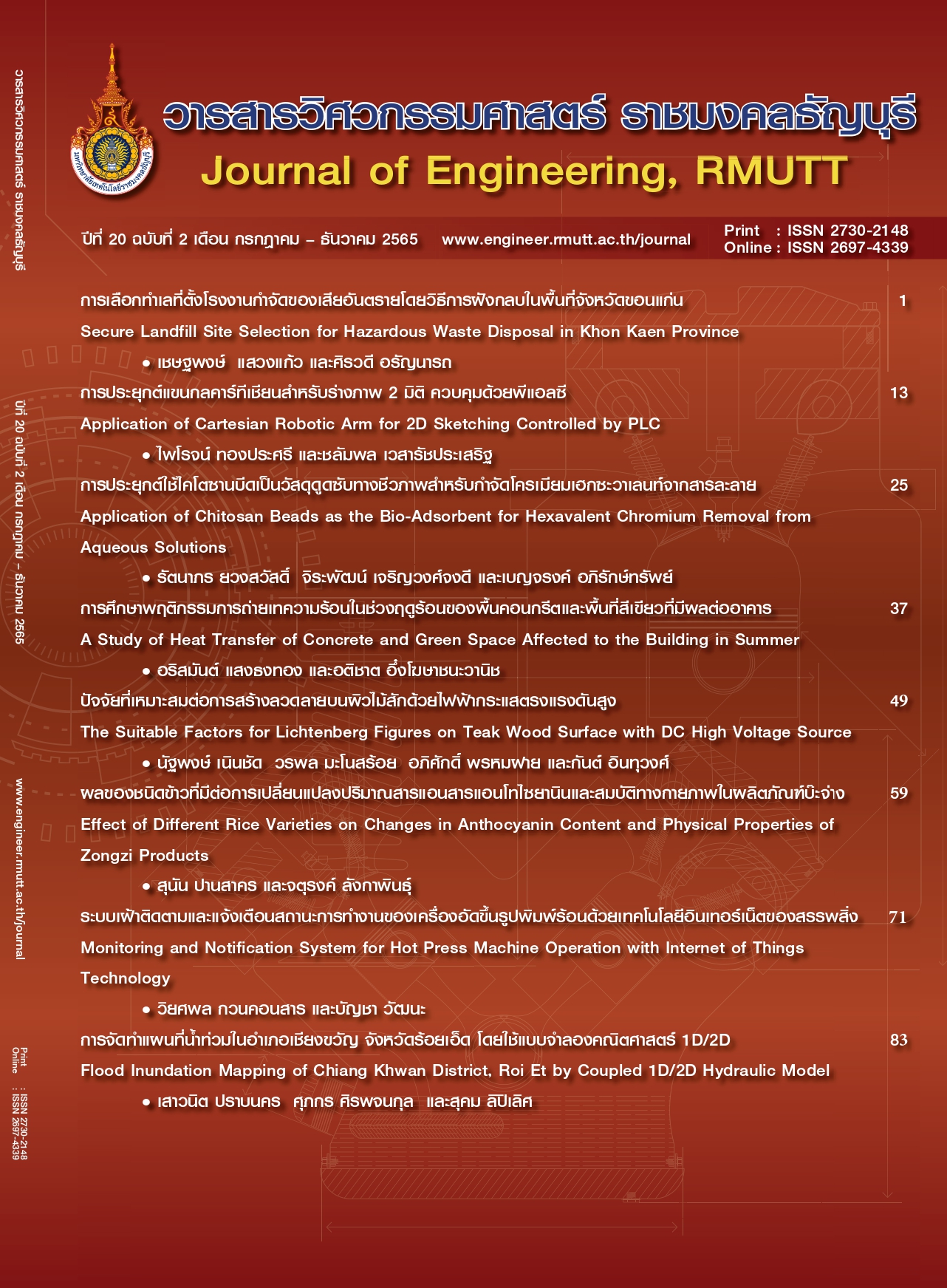Flood Inundation Mapping of Chiang Khwan District, Roi Et by Coupled 1D/2D Hydraulic Model
Main Article Content
Abstract
Chiang Khwan district in Roi Et has been experienced recurring floods. Over the past 12 years (2010-2021), 9 flood events occurred at Chiang Khwan, resulting in the loss of lives and properties. This research aims to identify flood areas at Chiang Khwan district at 2-, 5-, 10-, 25-, 50- and 100-year return periods. The design floods and water level elevations are estimated by the Gumbel distribution. Those are inputs into a 1D/2D hydraulic model of the Chi River developed for flood inundation mapping. At satisfactory calibration and validation results, the R2 > 90% and RMSE < 1 m, the model demonstrates that, at the above return periods, approximately 22,792; 36,554; 39,053; 41,476; 43,965 และ 45,349 rai are inundated, respectively. For the 2- and 5-year return periods, the flood depths vary mostly between 0-2 m, and that for other return periods vary mostly between 0-4 m. The flooding begins at Chiang Khwan sub-district, located shortly downstream of the Lam Pao, which receives water from Lam Pao Dam. However, after a while, due to narrower river cross-sections downstream, which significantly reduce the river's drainage capacity, a huge volume of water accumulates, overflows its banks, and starts flooding downstream. As a result, Phlapphla, Phra That, and Chiang Khwan sub-districts are most affected, respectively. This information and flood inundation maps are useful for developing flood-control measures, flood resilient design, and emergency action plan to protect and reduce adverse impacts from future floods.
Article Details

This work is licensed under a Creative Commons Attribution-NonCommercial-NoDerivatives 4.0 International License.
The manuscript, information, content, picture and so forth which were published on Frontiers in engineering innovation research has been a copyright of this journal only. There is not allow anyone or any organize to duplicate all content or some document for unethical publication.
References
EM-DAT, CRED/UCLouvain, Brussels, Belgium [Internet]. 2022 [cited May 24, 2022]. Available from: www.emdat.be.
Flood event records [Internet]. National Hydroinformatics Data Center. 2022. Available from: http://www.thaiwater.net/report#flood (in Thai)
Koivumäki L, Alho P, Lotsari E, Käyhkö J, Saari A, Hyyppä H. Uncertainties in flood risk mapping: a case study on estimating building damages for a river flood in Finland.Journal of flood risk management. 2010;3(2):166-83.
Van Alphen J, Passchier R. Atlas of Flood Maps, examples from 19 European countries, USA and Japan, Ministry of Transport. Public Works and Water Management, The Hague, Netherlands, prepared for EXCIMAP, available at: http://ec europa eu/environment/water/flood risk/flood atlas/index htm. 2007.
European Parliament. Directive 2007/60/EC of the European Parliament and of the Council of 23 October 2007 on the assessment and management of flood risks 2007.
de Moel H, van Alphen J, Aerts JCJH. Flood maps in Europe-methods, availability and use. Nat Hazards Earth Syst Sci. 2009;9(2):289-301.
Bubeck P, Kreibich H, Penning Rowsell EC, Botzen W, De Moel H, Klijn F. Explaining differences in flood management approaches in Europe and in the USA–a comparative analysis. Journal of Flood Risk Management. 2017;10(4):436-45.
Demir V, Kisi O. Flood hazard mapping by using geographic information system and hydraulic model: Mert River, Samsun, Turkey. Advances in Meteorology. 2016;2016:9.
Doong D-J, Lo W, Vojinovic Z, Lee W-L, Lee S-P. Development of a new generation of flood inundation maps A case study of the coastal city of Tainan, Taiwan. Water. 2016;8(11):521.
Mosquera-Machado S, Ahmad S. Flood hazard assessment of atrato river in colombia.Water resources management. 2007;21(3):591-609.
Wikipedia the free encyclopedia. Amphoe Chiang Khwan (in Thai): Wikipedia the free encyclopedia; 2022 [updated 10 February 2022; cited 2022 13 June]. Available from:https://th.Wikipedia.org/wiki/
AmphoeChiangKhwan.
Panban P, Ngamlarp D, Masari A, Thepprasit C. Comparison of annual maximum series and partial maximum series for flood frequency analysis. Journal of Science and Technology Kasetsart University. 2019;8(2):32-41. (in Thai)
Brunner GW. HEC-RAS River Analysis System Hydraulic Reference Manual Version 5.0. Davis, CA, USA: US Army Corps of Engineers, Institute for Water Resources, Hydrologic Engineering Center (HEC); 2016 February, 2016. 547 p.
Brunner GW.HEC-RAS River Analysis System, User's Manual Version 5.0. Davis, CA, USA: US Army Corps of Engineers, Institute for Water Resources, Hydrologic Engineering Center (HEC); 2016 February 2016. 962 p.
Brunner GW. HEC-RAS River Analysis System, 2D Modeling User's Manual Version 5.0. Davis, CA, USA: US Army Corps of Engineers, Institute for Water Resources, Hydrologic Engineering Center (HEC); 2016 February 2016. 171 p.
Kuntiyawichai K. Interactions between Land Use and Flood Management in the Chi River Basin. Delft, the Netherlands: UNESCO-IHE Institute of Water Education and Wageningen University; 2012.
Chow VT. Open-channel hydraulics. Open-channel hydraulics. NY.: McGraw-Hill; 1959.


